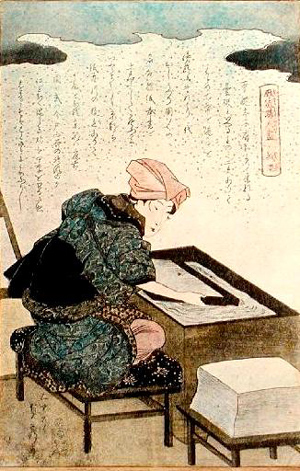Japanese Washi Paper

Washi is the light, strong traditional Japanese paper made by hand from the inner-bark fibers of three plants. The name washi literally means "Japanese paper". Today most paper in Japan is made in large automated mills, but a few hundred families in rural villages continue to make washi in the traditional way.
Traditionally, Japanese farmers make paper in the winter after all of the other crops have been harvested. The cold temperatures keep the organic materials fresh. The fibers in the pulp also contract in the cold weather and form a stronger sheet of paper.
Since paper is essentially a combination of vegetable fibers and water, pure cold water is also vital to the art of making washi. Any minerals or impurities in the water will eventually mar the paper. The final ingredient in high quality paper is, of course, the fibers that are used. The three fibers used to create washi are kozo, gampi and mitsumata.
(text and background only visible when logged in)
Washi Fibers and Harvesting
Kozo
The cultivation and harvesting of the fiber varies depending on the plant. The most common, Kozo, has grown in the wild for centuries in Japan.
Kozo is easily cultivated in either wet or dry fields, and yields better quality and quantity of fibers than its wild brethren. It takes two to three years for the bark of the Kozo to mature enough to be used for paper making. Harvesting of the Kozo occurs in the late fall or early winter after the leaves have dropped.
Shoots of Kozo are cut near the base of the of the plant, and cut into uniform pieces between fifteen inches and four feet, depending on the limitations of the steamer. The shoots are tied into bundles that can weigh over forty-five pounds.
(text and background only visible when logged in)
Mitsumata
Mitsumata is typically cultivated on hillsides, interspersed with Japanese cedars and cypress trees.It is harvested in much the same way as Kozo, except the tied bundles are often placed in rivers after harvesting to preserve freshness.
Mitsumata produces fibers that are soft, absorbent, and insect resistant. Its fibers are relatively short and form a sponge-like network. It is often used in combination with other fibers. Pure mitsumata produces a very fine writing paper. The highest quality fibers are used in making the paper that Japanese bank notes are printed on.
(text and background only visible when logged in)
Gampi
Gampi, the most temperamental of the three, is harvested in the spring, when the plants are saturated with water and sap. Gampi can neither be steamed like Kozo or Mitsumata, nor cultivated with much success.
The gampi plant grows in the wild. Its extremely tough, long fibers must be harvested from February to May. The naturally damp-resistant and insect-resistant fibers are excellent for making long-lasting paper. The slick, lustrous paper makes a distinct crackling sound when handled. The scarcity of gampi fibers and the high quality of the product make gampi a very rare and expensive paper. It is often used as calligraphy paper or in the pounding of gold leaf.
(text and background only visible when logged in)